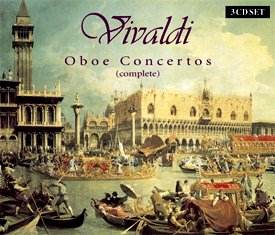Vivaldi is known mainly for his numerous violin concertos.
But he came to explore woodwind instruments through his interactions
with travellers to Venice (among them G. H. Stoltzel and Johann
Heinichen) and his own travels to Germany and France. Also, his
obligations to produce music for the instruments to be played at
the Ospedale and abroad led to his using a variety of instruments
in concerti. The oboe became very popular in the early eighteenth
century. It first appeared in St. Mark's in 1698, and the Ospedale
della Pieta employed oboe teachers from 1703 onwards. Vivaldi's
sonata RV 779 contains a very demanding part for the oboe dated
to 1710 and his opera 'Ottone in Villa' of 1713 contains a significant
oboe part.
As was his way (and that of many others) Vivaldi
did his share of self-borrowing, so that eight of the surviving
oboe concertos exist in other forms. For instance RV448 was reworked
both as a bassoon concerto (RV470) and another oboe concerto (RV447).
The concertos were not necessarily all written
for use at the Pieta. Many of them may well have been written
for virtuosos to play at private performances for the nobility
either in Venice or perhaps at the Saxon Court in Dresden, where
Vivaldi had contacts. The form and orchestration of the works
make them eminently suitable for a small group of players to perform
for the delectation of a group of aristocrats in a Venetian Palazzo.
These disks contain all the surviving concerti,
including three for two oboes. There are 17 works here, lasting
a total of 150 minutes. None of the concertos is long (under ten
minutes each) and all, except one, have essentially the same 3
movement fast-slow-fast form. The slow movements can be tender
and elegant, evoking wistfulness and longing. But none explore
the vein of profound melancholy of which the oboe is capable;
these works were written to entertain.
Whether due to the presence of splendidly talented
girls at the Pieta or to the power of other virtuosos, Vivaldi
asked a lot of the reed-blowing soloists of his time. Their instruments
were devoid of most of today's key ironmongery, but even on a
modern instrument the oboe concertos are still a challenge. Vivaldi
expects his soloist to be able to cope with long phrases with
hardly a breathing space and very violinistic figurations. Burkhard
Glaetzner, playing on a modern instrument, not only rises to that
challenge brilliantly but also directs the group. Constantly mellifluous
of tone, he never betrays the slightest problem with any of Vivaldi's
many technical challenges and takes some of the movements at breathtakingly
brilliant speeds. In the slower movements his tone captures the
atmosphere beautifully with never a bulge or awkward moment. In
the concertos for two oboes, Glaetzner is ably partnered by Ingo
Goritzki.
Playing on modern instruments but with vibrato
kept well under control, Neues Bachisches Collegium Musicum Leipzig
make a fine partner for Glaetzner. They play crisply and accurately,
even at the brisk speeds that he takes some of the faster movements.
But their playing, though quite stylish, has a certain solidity
to it. I would have liked more bounce and much more of a feel
for the dance element in some of the accompaniments. This is particularly
true when the whole ensemble is playing in the faster movements,
and the bass line has a certain heaviness that I do not like.
Some of this, of course, is down to personal preference and with
playing as brilliant as Glaetzner's, it should not put you off
this set.
Robert Hugill

